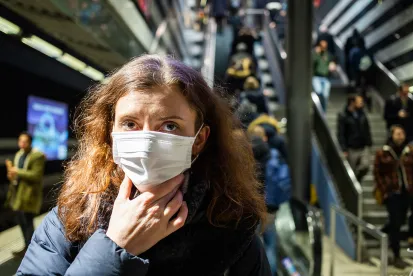President Trump signed the Families First Coronavirus Response Act into law late Wednesday night. We summarize the enacted version below (which replaces our analysis of an earlier version the House passed, which it since amended). The law goes into effect into effect April 2, 2020 and will remain in place until the end of the year.
In short, the new law, among other things: (1) extends and expands the protections of FMLA job-protected leave for certain childcare-COVID-19-related absences, including requiring paid FMLA leave benefits; (2) provides a new paid sick leave entitlement for certain COVID-19-related absences; (3) provides tax credits to help employers defray the costs of paying these benefits; and (4) provides grants to eligible states to further fund their unemployment trust fund accounts. Importantly, the law’s new entitlements only remain in effect through 2020. We outline key portions below.
-
The law expands the FMLA’s reach to provide job protection and partial wage replacement for impacted employees.
The Emergency Family and Medical Leave Expansion Act amends the Family Leave and Medical Leave Act of 1993 by permitting eligible employee to use FMLA leave related to a public health emergency for child-care related absences. Below are key considerations for employers related to these amendments:
-
The new law applies only to employers with fewer than 500 employees. Employees working for at least 30 days for a covered employer are eligible immediately to use leave. The DOL has the power to exclude employers with fewer than 50 employees where a hardship exemption applies.
-
Eligible employees may take up to twelve (12) weeks of job-protected FMLA leave where they are unable to work or telework because of a need for leave to care for a son or daughter if their (primary or secondary) school or place of care has been closed, or their child-care provider is unavailable, because of a public health emergency declared with respect to COVID-19- coronavirus.
-
This is a significant change from the prior version that would have also permitted leave where the employee received a recommendation to quarantine or where the employee needed to care for a family member recommended to quarantine.
-
-
The first 10 days of FMLA leave is unpaid, but employees may elect to substitute accrued vacation, personal leave, or sick leave for the unpaid leave under this section. An employer may not require such substitution.
-
A prior version made the first 14 days unpaid.
-
-
After the 10 days are exhausted, employers must pay the employee not less than two-thirds of the employee’s regular rate of pay for each day of FMLA leave taken thereafter, capped at $200 per day, and $10,000 in the aggregate.
-
This is a big development as there was no cap under the prior version.
-
-
There are separate provisions regarding this paid leave benefit for employees subject to a multi-employer collective bargaining agreement.
-
For the most part, this is job-protected leave. But employees taking leave provided under this law do not have any greater right to continued employment than those not on leave, and further, there are some additional limitations to job-protection rights for employees working at an employer with fewer than 25 employees.
-
The law goes into effect April 2, 2020 and remains in effect until December 31, 2020.
-
The law provides a new paid sick leave entitlement to impacted employees.
The new law also includes the Emergency Paid Sick Leave Act, which permits employees to use sick leave related to COVID-19, the key components of which are set forth below.
-
Like the FMLA expansion, this applies to employers with fewer than 500 employees. It may also exclude employers with fewer than 50 employees where a hardship exemption applies.
-
A prior version did not include the hardship exemption.
-
-
All full-time employees (subject to limited exceptions) regardless of their length of employment are entitled to take 80 hours paid sick leave immediately. Part-time employees get a pro-rated amount.
-
These new sick leave amounts are in addition to and not in lieu of any other statutorily provided or employer-provided paid sick leave benefits, and further, employers must permit employees to use COVID-19-related sick leave before other sick leave.
-
These amounts cannot be carried over into the new year, nor are they paid out at termination.
-
Employees could use this sick leave where they cannot work or telework because:
-
They are subject to a Federal, State, or local quarantine or isolation order related to COVID-19;
-
The employee has been advised by a health care provider to self-quarantine due to COVID-19-related concerns;
-
The employee is experiencing symptoms of COVID-19 and seeking a medical diagnosis;
-
The employee is caring for someone who is subject to a quarantine or isolation order or who has been advised to self-quarantine;
-
The employee is caring for a child if the child’s school or place of care is closed or the child-care provider is unavailable because of COVID-19 precautions; or
-
The employee is experiencing any other substantially similar condition specified by the Secretary of Health and Human Services in consultation with the Secretary of Treasury and the Secretary of Labor.
-
A prior version identified a broader set of reasons to use leave.
-
Employers are required to pay an employee (i) at his or her regular rate of pay up to a cap of $511 per day and $5,110 in the aggregate for sick leave use under reasons (1)-(3) above (employee quarantine or isolation order, self-quarantine recommendation or experiencing symptoms and seeking treatment), and (ii) at 2/3rds his or her regular rate of pay capped at $200 per day and $2,000 in the aggregate for sick leave use under reasons (4)-(6) above (caring for others and additional government-specified conditions).
-
This is a big development as there was no cap under the prior version.
-
-
There are separate provisions regarding this paid sick leave benefit for employees subject to a multi-employer collective bargaining agreement.
-
Employers must post a notice related to this section in a conspicuous place in the workplace. A model notice will be provided by the Department of Labor by next week.
-
The law also goes into effect April 2, 2020 and remains in effect until December 31, 2020.
-
The law provides tax credits to employers paying out leave benefits.
The Tax Credits For Paid Sick And Paid Family And Medical Leave Act provides a refundable tax credit equal to 100% percent of qualified paid leave benefits paid by an employer subject to certain caps and offset against social security taxes paid by the employer.
-
The law allots $1 billion for unemployment insurance benefits.
The government will provide emergency grants to eligible states to pay out unemployment insurance benefits.
-
What’s next and what to expect.
Employers should plan to do the following:
-
Confirm employee headcount, taking into account part-time employees and any planned layoffs, to determine which provisions of the law would apply;
-
Think about drafting a stand-alone emergency leave policy that outlines these FMLA and sick leave rights, with an eye for ensuring that this policy aligns with the company’s leave of absence, sick leave, and PTO policies;
-
Prepare to account for the new paid FMLA and sick leave entitlements from a financial/accounting perspective;
-
Consider potential fluctuations in staffing levels in anticipation of employees taking advantage of these leave entitlements this calendar year; and
-
Be mindful of parallel or overlapping leave and PTO requirements under applicable state and local laws.





 />i
/>i

